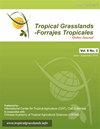柠檬酸渣和乳酸菌青贮纳皮草发酵品质及好氧稳定性
IF 0.7
4区 农林科学
Q3 AGRICULTURE, DAIRY & ANIMAL SCIENCE
引用次数: 2
摘要
本试验研究了在紫穗草(Cenchrus purpureus)中添加柠檬酸渣(CAR)和不添加乳酸菌(LAB)的效果;同义:狼尾草对苏木2号青贮发酵品质和青贮好氧稳定性的影响。处理包括:对照(不加添加剂的纳皮尔草料);以1 × 10 cfu/g鲜重(FW)饲料(LAB)或36 g柠檬酸渣/kg鲜重(FW)饲料(CAR)或CAR与LAB的混合物(CL)接种乳酸菌(植物乳杆菌和布氏乳杆菌)。青贮45 d后进行青贮化学成分和微生物组成测定,并进行好氧稳定性试验。与对照组相比,添加CAR或不添加LAB均提高了青贮DM和乳酸浓度,降低了pH +乙酸、氨氮(NH3-N)、中性洗涤纤维和纤维素浓度。LAB青贮pH值低于对照,乳酸浓度高于对照。在有氧暴露的前2天,所有添加剂都增加了水溶性碳水化合物(WSC)和乳酸浓度,降低了pH、NH3-N和乙酸浓度。在好氧条件下,CL青贮的WSC最高,NH3-N和乙酸浓度最低。然而,所有添加剂均未能改善青贮饲料的有氧稳定性。虽然添加或不添加LAB接种剂的CAR均能提高纳匹尔草青贮的发酵品质,但还需要更多的研究来确定能提高青贮开仓后好氧稳定性的添加剂。本文章由计算机程序翻译,如有差异,请以英文原文为准。
Fermentation quality and aerobic stability of Napier grass ensiled with citric acid residue and lactic acid bacteria
This study was conducted to investigate the effects of adding citric acid residue (CAR) with or without lactic acid bacteria (LAB) to Napier grass (Cenchrus purpureus; syn. Pennisetum purpureum) cv. Sumu No. 2 at ensiling on the fermentation quality and aerobic stability of the resulting silage. Treatments included: Control (Napier grass forage without additives); and Napier grass inoculated with lactic acid bacteria (Lactobacillus plantarum and L. buchneri) at 1 × 10 cfu/g fresh weight (FW) forage (LAB) or 36 g citric acid residue/kg FW forage (CAR) or a mixture of CAR and LAB (CL). Forty-five days after ensiling the silages were tested for chemical and microbial composition and an aerobic stability test was conducted. The addition of CAR with or without LAB increased the DM and lactic acid concentrations in silage and decreased pH plus acetic acid, ammonia nitrogen (NH3-N), neutral detergent fiber and cellulose concentrations relative to Control. The pH in LAB silage was lower than in Control, while lactic acid concentration was higher. During the first 2 days of aerobic exposure, all additives increased the water-soluble carbohydrate (WSC) and lactic acid concentrations and decreased pH plus NH3-N and acetic acid concentrations. Moreover, CL silages had the highest WSC and the lowest NH3-N and acetic acid concentrations during aerobic exposure. However, all additives failed to improve the aerobic stability of the silage. While CAR with or without LAB inoculant improved the fermentation quality of silage made from Napier grass, more studies are warranted to identify additives which can improve aerobic stability of the silage after opening.
求助全文
通过发布文献求助,成功后即可免费获取论文全文。
去求助
来源期刊

Tropical Grasslands-Forrajes Tropicales
Agricultural and Biological Sciences-Agronomy and Crop Science
CiteScore
1.60
自引率
0.00%
发文量
36
审稿时长
16 weeks
期刊介绍:
The Journal publishes, in English or Spanish, Research Papers and Short Communications on research and development, as well as contributions from practitioners (Farmer Contributions) and Review Articles, related to pastures and forages in the tropics and subtropics. There is no regional focus; the information published should be of interest to a wide readership, encomprising researchers, academics, students, technicians, development workers and farmers.
In general, the focus of the Journal is more on sown (''improved'') pastures and forages than on rangeland-specific aspects of natural grasslands, but exceptions are possible (e.g. when a submission is relevant for a particularly broad readership in the pasture and forage science community).
The Journal will also consider the occasional publication of associated, but closely related, research in the form of an additional scientific communication platform [e.g. a re-make of the former Genetic Resources Communication series of the former Division of Tropical Crops and Pastures of the Commonwealth Scientific and Industrial Research Organisation (CSIRO), Australia].
Areas of particular interest to the Journal are:
Forage Genetic Resources and Livestock Production[...]
Environmental Functions of Forages[...]
Socio-economic Aspects[...]
Topics within the aforementioned areas may include: Diversity evaluation; Agronomy; Establishment (including fertilization); Management and utilization; Animal production; Nutritive value; Biotic stresses (pests and diseases, weeds); Abiotic stresses (soil fertility, water, temperature); Genetics and breeding; Biogeography and germplasm collections; Seed production; Ecology; Physiology; Rhizobiology (including BNF, BNI, mycorrhizae); Forage conservation; Economics; Multilocational experimentation; Modelling.
 求助内容:
求助内容: 应助结果提醒方式:
应助结果提醒方式:


